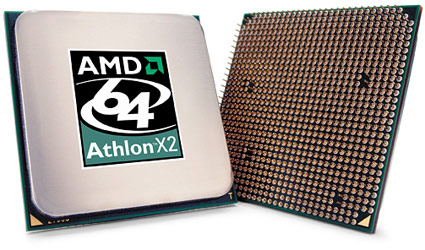Gaming With AGP Graphics: Overclock That CPU!
Your Old System: Better, Faster, Stronger
You've got an older AGP-equipped system lying around. After checking out our last AGP article, you've accepted that the old girl won't be a valuable addition to LAN parties anymore. But before you go and donate it to your auntie for basic Internet use, hold on a minute. There might be some gaming goodness left in that system.
To recap, in part one of our little AGP Revival, we paired the latest and greatest AGP graphics cards with a fairly typical older platform. This system was equipped with an AGP motherboard, a dual-core Athlon X2 3800+ CPU, and 2GB of DDR memory. While the AGP bus didn't seem to be too much of a limiting factor, the CPU certainly turned out to be quite the bottleneck.
While this isn't a desirable situation to be in for a gamer, due to the limited CPU upgrade options today, it does lend itself to some affordable overclocking. The beauty of a CPU bottleneck (if you want to call it that) is that overclocking so effectively circumvents them. While graphics card overclocks usually produce relatively limited results, overclocking the CPU of a processor-bottlenecked system can show some big gains.
Let's clear something up first, though: this route won't work for everyone with an AGP system. In order for your older, overclocked processor to keep up with a higher-end graphics card, you're going to need an AGP motherboard that can handle a dual-core CPU at the very least, because a majority of new games need a minimum of two cores for good performance. That means your AGP motherboard must support AMD's Socket 939, AM2, or Intel's LGA 775 interface.
With these basic guidelines covered, let's look into the specifics of how we can squeeze the most performance from our old AGP system, while spending the least amount of cash.
Get Tom's Hardware's best news and in-depth reviews, straight to your inbox.
Current page: Your Old System: Better, Faster, Stronger
Next Page Optimizing Our AGP Platform: ASRock Dual939-SATA2Don Woligroski was a former senior hardware editor for Tom's Hardware. He has covered a wide range of PC hardware topics, including CPUs, GPUs, system building, and emerging technologies.
-
megamanx00 Yeah, playing Crysis on low aint too fun :D. Still a 3850 with a 2.6GHz X2 is enough for mostly medium details at like 1024x768 or 1280x1024. Anyway yeah getting anything more than a 2600XT for an old AGP system requires an overclocked dual core. Would have been nice to see some numbers from an overclocked dual core P4, since there are a few of those on AGP out there, but I'm sure the results would have been pretty pretty sad ^_^.Reply -
masterjaw This is a memorabilia on how AGP-based systems struggle to perform well with recent games. Still, an overall upgrade would still be way better than buying one of these old timers and try to suspend the inescapable destruction.Reply -
jamesedgeuk2000 "Still, an overall upgrade would still be way better than buying one of these old timers and try to suspend the inescapable destruction."Reply
Yes because buying a new motherboard AND cpu AND memory AND gfx card is cheaper than buying a gfx card and overclocking your cpu isnt it? -
manjyomethunder jamesedgeuk2000"Still, an overall upgrade would still be way better than buying one of these old timers and try to suspend the inescapable destruction."Yes because buying a new motherboard AND cpu AND memory AND gfx card is cheaper than buying a gfx card and overclocking your cpu isnt it?Reply
In the long run yes, seeing as the AGP Radeon 4650 is twice the price of the PCI-Express version anyway, so there's some money saved right there anyway. In the case that you have one of these ridiculous Socket 939 ASRock boards with the AM2 daughterboard...I mean really? You'd rather buy an overpriced GPU, new RAM and an outdated CPU so that you don't have to buy an ENTIRELY new motherboard? It's not even worth it. -
masterjaw jamesedgeuk2000Yes because buying a new motherboard AND cpu AND memory AND gfx card is cheaper than buying a gfx card and overclocking your cpu isnt it?Reply
IIRC, I said better not cheaper. Sure thing, you could save some money by buying AGP chips for your aging components. Spending $100 for an AGP card that is way below the performance of the equally-priced 4850. Is it worth it? No. For the mean time, you could survive playing at low settings but how long will your system hold on? By the time your system quits, you might be even thinking if you should've saved that $100 and just upgraded the whole system for the long run. This AGP cards recently released are just a remedy, not a solution. Still a full upgrade is an imminent path that those with old systems must take.
-
marcos669 Well, this is better tomshardware, but isn´t still enough, put the AGP cards in an Asrock AliveDual-esata2 or the AM2NF3-VSTA,with athlon 5xxx or 7xxx and DDR2-800 memory, and you will see 3850 AGP can be much more competitive and Crysis can be Played in High settings.Reply
I think i would be a good idea, but the web y your, of course, but it will be fine for this people that say the 3850 AGP is not fine, the would see they are completly wrong. -
rickzor Aww this is my motherboard! Although i dont use the daughterboard but instead a use the pci-e on the motherboard (yes it comes with both, pci-e and agp) with a gf9600gt, and a powerful athlon 64 3500+ overclocked to 2.5ghz.Reply
It's my main computer. -
rickzor Aww this is my motherboard! Although i dont use the daughterboard but instead a use the pci-e on the motherboard (yes it comes with both, pci-e and agp) with a gf9600gt, and a powerful athlon 64 3500+ overclocked to 2.5ghz.Reply
It's my main computer.

